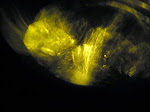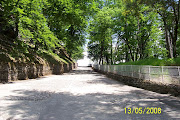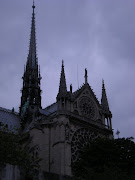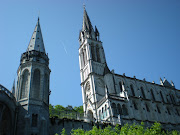
Konsili Ekumenis Lateran IV pada tahun 1215 AD , Paus: Pope Innocent III
C O N S T I T U T I O N S
1. * Confession of Faith *
We firmly believe and simply confess that there is only one true God,
eternal and immeasurable, almighty, unchangeable, incomprehensible and
ineffable, Father, Son and holy Spirit, three persons but one absolutely
simple essence, substance or nature {1} . The Father is from none, the Son
from the Father alone, and the holy Spirit from both equally, eternally
without beginning or end; the Father generating, the Son being born, and the
holy Spirit proceeding; consubstantial and coequal, co-omnipotent and
coeternal; one principle of all things, creator of all things invisible and
visible, spiritual and corporeal; who by his almighty power at the beginning
of time created from nothing both spiritual and corporeal creatures, that is
to say angelic and earthly, and then created human beings composed as it
were of both spirit and body in common. The devil and other demons were
created by God naturally good, but they became evil by their own doing. Man,
however, sinned at the prompting of the devil.
This holy Trinity, which is undivided according to its common essence but
distinct according to the properties of its persons, gave the teaching of
salvation to the human race through Moses and the holy prophets and his
other servants, according to the most appropriate disposition of the times.
Finally the only-begotten Son of God, Jesus Christ, who became incarnate by
the action of the whole Trinity in common and was conceived from the ever
virgin Mary through the cooperation of the holy Spirit, having become true
man, composed of a rational soul and human flesh, one person in two natures,
showed more clearly the way of life. Although he is immortal and unable to
suffer according to his divinity, he was made capable of suffering and dying
according to his humanity. Indeed, having suffered and died on the wood of
the cross for the salvation of the human race, he descended to the
underworld, rose from the dead and ascended into heaven. He descended in the
soul, rose in the flesh, and ascended in both. He will come at the end of
time to judge the living and the dead, to render to every person according
to his works, both to the reprobate and to the elect. All of them will rise
with their own bodies, which they now wear, so as to receive according to
their deserts, whether these be good or bad; for the latter perpetual
punishment with the devil, for the former eternal glory with Christ.
*There is indeed one universal (baca: Katolik) church of the faithful,
outside of which nobody at all is saved, in which Jesus Christ is both
priest and sacrifice.* His body and blood are truly contained in the
sacrament of the altar under the forms of bread and wine, the bread and wine
having been changed in substance, by God's power, into his body and blood,
so that in order to achieve this mystery of unity we receive from God what
he received from us. Nobody can effect this sacrament except a priest who
has been properly ordained according to the church's keys, which Jesus
Christ himself gave to the apostles and their successors. But the sacrament
of baptism is consecrated in water at the invocation of the undivided
Trinity -- namely Father, Son and holy Spirit -- and brings salvation to
both children and adults when it is correctly carried out by anyone in the
form laid down by the church. If someone falls into sin after having
received baptism, he or she can always be restored through true penitence.
For not only virgins and the continent but also married persons find favour
with God by right faith and good actions and deserve to attain to eternal
blessedness.Beberapa kali saya pernah didatangi orang – orang Saksi Yehovah, yang ingin berbicara tentang kitab suci tetapi saya menolak karena saya tahu bahwa iman keyakinan saya dengan mereka berbeda meski kitab sucinya sama, akan tetapi mereka tidak mengakui Yesus sebagai Tuhan tetapi sebagai manusia sesama ciptaan Tuhan. Bukan saya takut terpengaruh akan tetapi mungkin saya merasa akan membuang waktu saya. Mempermasalahkan bahwa Kristus bukanlah Tuhan adalah sama dengan mengusik iman kristiani yang menerima keyakinan bahwa Yesus sungguh Allah dan sungguh manusia. Juga meragukan iman Trinitas yang diimani para penganut Katolik dan Kristen. Teolog iman katolik Thomas Aquinas yang banyak dipakai dari kumpulan tulisannya "Summa Theologia", sebagai referensi akhirnya menyatakan juga bahwa kita akhirnya tidak memahami Allah dengan sepenuh - penuhnya ; bahwa Allah itu tak terkatakan. Kita adalah seperti orang buta yang diberitahu indahnya warna biru, dan bagaimanapun orang menggambarkan indahnya warnabiru tersebut, kita yang buta tidak pernah dapat memahaminya dengan benar. Tidak salah kalau Kahlil Gibran pernah mengatakan bahwa iman adalah oasis yang tak pernah terjangkau oleh kafilah alam pikiran. Pemuaskan dahaga kita akan kebenaran dan pengertian tentang Pencipta ; dan bagi kita pengikut Kristus tentang Sang Sabda, adalah proses spiritual sepanjang kehidupan kita.
Baru baru ini saya juga membaca sepintas sebuah buku “the other bible” tulisan seorang Ph D theologi yang membahas injil-injil lain yang tidak diakui Vatican dan Kekristenan lainnya seperti Injil Thomas, Mary Magdalene, James, Judas, Barnabas dan juga aprokip2 Judaism, dll/ Saya tidak mendalami, Cuma tertarik karena dalam preface disampaikan dari injil tersebut meski tidak diakui oleh Christianity tetapi juga ada yang membawa kita untuk lebih menghayati faith kita dan memang saya tertarik karena banyak yang merupakan cerita imaginative atau memperkaya iman saya , dan bagi saya bukanlah sesuatu yang negative. Kalau saya tidak salah populernya Da Vinci Code juga adalah berdasar injil Judas yang diekslpoitasi Dan Brown menjadi novel yang popular dan semuanya menjadi logic dan menarik bila dikait-kaitkan. Memang seperti nya kalau ke4 injil yang kita pegang sekarang ini selesai ditulis tahun 90 an dengan injil yang terakhir adalah Yohanes , saudara Jakobus yang sebelumnya adalah para murid Yohanes Pembaptis; dianggap oleh banyak para ahli sebagai injil kasih yang ingin menegaskan bahwa Yesus adalah Allah sendiri.
Dalam sejarah gereja pada abad-abad pertama memang banyak ajaran yang mempersoalkan ajaran untuk menegaskan siapakah diri Yesus sebenarnya. Yang ekstrem disatu sisi bahwa Yesus adalah Allah sepenuhnya yang menjelma sebagai manusia ( biasanya seperti yang terjadi dalam Mythologi Junani ataupun Timur menitis jadi manusia). Yesus bagaikan meminjam badan manusia sampai pada suatu saat disalib tanpa kesakitan. Pada ekstrem lainnya Yesus seratus persen sama seperti kita yang memiliki banyak kelemahan tetapi menjadi sempurna karena mengutamakan kehemdak Allah. Banyak ajaran-ajaran lainnya yang akhirnya melahirkan seperti injil-injil yang disebutkan dalam the other bible, karena waktu itu alam pemikiran banyak dipengaruhi alam filsafat Yunani ( sumber ilmu pemikiran dan pengetahuan yang menjadi cernaan para intelektual saat itu). Pemikiran Socrates, Plato dan Aristoteles yang mengutamakan rasio atau akal budi yang berdasarkan logika. Buah dari pemikiran inilah yang melahirkan injil – injil Gnotis yang bukan kanon gereja katolik. Bukan injil palsu tetapi ditulis oleh penulis yang tidak termasuk dalam kanon Gereja atau menawarkan rahasia pengetahuan dalam mencoba mencari jawab siapakah atau pemahaman tentang Yesus itu. Ada buku The Other Bible yang ditulis Willy B dari Harper yang menganalisa tentang injil - injil tersebut
.......
Gathered here for the first time in one comprehensive volume are excerpted ancient holy texts from Judeo-Christian traditions that were excluded from the official canon of the Old and New Testaments. The Other Bible is a unique sourcebook of essential selections from Jewish Psudepigrapha, early Kabbalah, Haggadah, Midrash, Christian Apocrypha, and Gnostic scriptures. The Other Bible provides a rare opportunity to discover the poetic and narrative riches of this long-suppressed literature and experience firsthand its visionary discourses on the nature of God, humanity, the spiritual life, the world around us, and infinite worlds beyond this one. Yang digambarkan oleh injil - injil ini seperti injil dari Maria Magdalena, Thomas, Filipus dsb yang disebut juga injil - injil apokrif ( jangan disamakan dengan deteuronika);
.....Diantaranya adalah apokrif sebagai berikut dibawah ini:
Apocrypha: The Gospel of Thomas
Apocrypha: Oxyrhynchus 1224 Gospel
Apocrypha: The Egerton Gospel
Apocrypha: The Gospel of Peter
Apocrypha: Secret Mark
Apocrypha: The Gospel of the Egyptians
Apocrypha: The Gospel of the Hebrews
Apocrypha: The Apocalypse of Peter
Apocrypha: The Secret Book of James
Apocrypha: The Preaching of Peter
Apocrypha: The Gospel of the Ebionites
Apocrypha: The Gospel of the Nazoreans
Apocrypha: The Oxyrhynchus 840 Gospel
Apocrypha: The Traditions of Matthias
Apocrypha: The Gospel of Mary
Apocrypha: The Dialogue of the Savior
Apocrypha: The Gospel of the Savior
Apocrypha: The Epistula Apostolorum
Apocrypha: The Infancy Gospel of James
Apocrypha: The Infancy Gospel of Thomas
Apocrypha: The Acts of Peter
Apocrypha: The Acts of John
Apocrypha: The Acts of Paul
Apocrypha: The Acts of Andrew
Apocrypha: The Acts of Peter and the Twelve
Apocrypha: The Book of Thomas the Contender
Apocrypha: The Acts of Thomas
(All of the above documents and more are presented on the Early Christian Writings web site).
Dalam "injil-injil" Gnotis , Yesus bukanlah Juru Selamat, sebagai nabi, atau Tuhan; akan tetapi sebagai pribadi istimewa yaitu seorang yang ahli filsafat yang serba tahu tentang segala macam hal. Diantaranya da yang imajinatif menggambarkan masa kecil Yesus , Yesus yang menjalin hubungan percintaan dengan Maria Magdalena, dsb. Yesus yang digambarkan oleh injil - injil ini adalah Yesus yang bukan Juru Selamat, dan bukan Yesus yang sesuai historik dan dan digambarkan oleh para penginjil yang diakui sebagai kanon oleh gereja , dan merupakan kanon kekristenan.
Akhirnya memang lahir konsili Nice pada tahun 325 yang melahirkan Nicene Creed. Injil Matius 28 :19 ….Karena itu pergilah, jadikanlah semua bangsa muridKu dan baptislah mereka dalam nama Bapa, Anak, dan Roh Kudus. Trinitas menjadi dasar pengakuan iman kekristenan kita, yang membedakan pengikut Kristus denga n Judaism dan Islam. Satu Tuhan dengan3 Keabadian yang abadi dari Allah Bapa, Putera, dan Roh Kudus. Misteri Tuhan menurut kekristenan adalah misteri iman Kristen, dan ini yang telah menimbulkan kekacauan penolakan Yesus sebagai Tuhan dan juga penolakan Roh Kudus, hanya pengertian Allah sebagaimana Judaism dan di kemudian hari Islam. Bila sekarang masih ada yang meragukan Trinitas saya kira adalah sekte-sekte dan mungkin julahnya tidak banyak, tetapi memang menarik bagi mereka yang mengeksplorasi pikiran – pikiran yang dirasakan berdasar logika. Seorang pastor pernah mengemukakan dirinya sebagai pengajar "ilmu" logika. Logika bukanlah suatu ilmu atau logos akan tetapi adalah adalah kemampuan atau cara berpikir secara rasional dan sistimatis sehingga dapat menyimpulkan sesuatu, atau dapat berargumen yang belum tentu diakui kebenarannya oleh orang lain. Disebut kemampuan cara berpikir sesorang atau reasoning terhadap segala sesuatu yang merupakan karakteristik orang yang bersangkutan. Dan biasanya berhubungan dengan tingkat kecerdasan yang bersangkutan. Logika bisa tidak berkwalitas biila berdasarkan statemen-statemen atau presumptions yang salah maka yang timbul adalah false logic. Saya tidak menyimpulkan bahwa penulis dari watchout illogic, akan tetapi iman kepercayaan kita memang menakui Allah Trinitas adalah iman yang kita anut berdasarkan religi kekristenan kita.
Injil Yohanes yang disebut juga adalah Para Phrase atau Pasa Graphe (Junani), menembus kalimat sering disebut juga the whole bible adalah semua yang tertulis merupakan kesaksian-kesaksian yang menyatakan Yesus adalah Allah, Sabda yang sudah menjadi daging, dan Rohnya yang berasal dari Bapa tetap abadi menyertai kita semua. Injil ini sering disebut injil hasil permenungan Yohanes, murid yang dikasihi, saudara Jakobus, sepupu Yesus, anak Salome saudara Maria dan anak dari Zebedeus; ingin menegaskan kepada kita semua bahwa Yesus adalah Allah sendiri. Oleh beberapa penafsir dianggap bahwa Yohanes dalam pemuridan oleh Yesus adalah yang dapat memahami dengan baik dengan kuasa Roh Kudus akan apa yang ingin disampaikan oleh Yesus. Dengan demikian dalam penulisan injilnya, ia bisa mengexpand apa yang dikehendaki Yesus . Bila injil Markus adalah untuk non believer , Matius untuk Yahudi kristen dan Lukas untuk kristen non Yahudi, adalah injil Yohanes yang ditujukan kepada pengikut yang telah matang (mature Cristian) atau kadang disebut untuk para penetua. Dan injil ini diakui sebagai kesaksian dari Allah sendiri yang menyatakan dirinya (Yoh1: 1 - 18), dan kesaksian-kesaksian saksi mata lainnya, dari Yohanes Pemandi, Nicodemus, Perwira romawi, Si Lumpuh di Siloam, dan Petrus bahwa Engkau adalah Yang Kudus dari Allah , Maria Magdalena dan dari Yesus sendiri. Ada 50 buah kata kesaksian disampaikan dalam injil Yohanes. Yohanes mengemukakan 7 kesaksian (tradisi Yahudi tujuh adalah sempurna) yang benar-benar meyakinkan melalui injilnya bahwa Yesus adalah Allah sendiri. Injil Yohanes juga mengajarkan banyak tentang Paracletes, Roh Kudus yang tidak meninggalkan kita sendirian.
Terima kasih rekan-rekan yang mau membaca ini, mungkin kita bisa saling memperkaya iman kita melalui pemahaman-pemahaman seperti yang diajarkan Gereja melalui Kitab Sucinya seperti yangdisampaikan Kardinal Joseph Ratzinger (waktu itu beliau menjadi Ketua Komisi Kitab Suci Kepausan) pada tanggal 23 April 1993 memperingati 100 tahun ensiklik Paus Leo Xiii, Providentissimus Deus dan 50 tahun ensiklik Divino Afflante Spiritu, yang keduanya dipersembahkan untuk kajian alkitab; beliau mengutip Luk 24:2
"……. semoga Anda dalam penelitian yang Anda lakukan, Anda selalu dibimbing oleh Yesus Kristus, Sabda Allah yang berinkarnasi, yang telah membuka para pikiran murid untuk dapat mengikuti Kitab Suci. Semoga Perawan Maria bisa menjadi teladan Anda melalui kepatuhannya kepada Sabda Allah. Dengan menyambut Sang Sabda , ia menjadi model dan ibu para murid. Oleh karena itu semoga dia mengajar Anda sekalian untuk menerima Sabda Allah secara penuh tetapi juga dalam seluruh hidup Anda".
(Komisi Kitab Suci Kepausan, Penafsiran Alkitab dalam Gereja, Kanisius, 2003)
Kemudian seperti dalam Deus Caritas Est
…….The Church, as Pope Benedict wrote, has three responsibilities: to preach the
Word of God, celebrate the sacraments and practice charity.
Dan juga liturgy ekaristi, beliau dalam ensiklik nya itu menyampaikan tanggung jawab gereja selain celebrating the sacrament dan kegiatan karitatif adalah preaching the Word, yang secara pribadi saya rasakan bukan pengajaran akhir2 ini di paroki St. Ignatius , tetapi saya rasakan sebagai permenungan yang lewat begitu saja dengan ilustrasi – ilustrasi yang irrelevant.

























.jpg)
